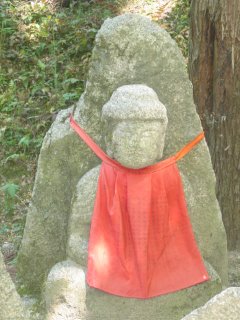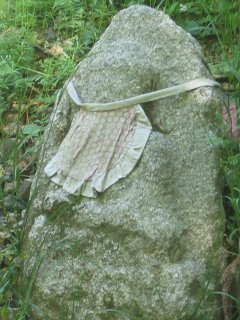

Dosojin (or Dousojin) refers to Shinto deities of roads and borders. Also called Sai no Kami or Dorokujin in some areas. These deities reside in stone markers found at village boundaries, in mountain passes, and along country byways. In urban areas today, dosojin stone markers are often placed at street corners and near bridges to protect pedestrians. As the deity of the village border, the dosojin wards off evil spirits and catastrophes, and protects the village from evil outside influences. As deity of the road, the dosojin protects travelers, pilgrims, and those in "transitional" stages. These stone markers may bear only inscriptions, but often they depict human forms, in particular the images of a man and woman -- the latter manifestation is revered as the kami (deity) of marriage and fertility. In some localities, the dosojin is worshiped as the kami of easy childbirth.


Japan's popular Fire Festivals, held around January 15 each year, are known as Dosojin festivals. Shrine decorations, talismans, and other shrine ornaments used during the local New-Year holiday are gathered together and burned in bonfires. They are typically pilled onto bamboo, tree branches, and straw, and set on fire to wish for good health and a rich harvest in the coming year. The practice of burning shrine decorations has many names, including Sai-no-Kami, Sagicho, and Dondo Yaki. According to some, the crackling sound of the burning bamboo tells the listener whether the year will be lucky or not. Children throw their calligraphy into the bonfires -- and if it flies high into the sky, it means they will become good at calligraphy.



The origin of dosojin stone markers is shrouded in the mists of uncertainty, and no exact date can be given. But precedents are ample in the Buddhist world. Here is the tale of one of Japan's most popular and beloved deities, Jizo Bosatsu. In the early centuries following the introduction of Buddhism to India (introduced around 500BC), Jizo became known as the guardian of travelers and pilgrims, and statues of his image could be found along pilgrimage routes and mountain passes in India and Southeast Asia. That tradition is still evident in modern Japan, where one often finds groupings of six Jizo statues standing guard on the high roads or at busy intersections.

 Dosojin (or Dousojin) refers to Shinto deities of roads and borders. Also called Sai no Kami or Dorokujin in some areas. These deities reside in stone markers found at village boundaries, in mountain passes, and along country byways. In urban areas today, dosojin stone markers are often placed at street corners and near bridges to protect pedestrians. As the deity of the village border, the dosojin wards off evil spirits and catastrophes, and protects the village from evil outside influences. As deity of the road, the dosojin protects travelers, pilgrims, and those in "transitional" stages. These stone markers may bear only inscriptions, but often they depict human forms, in particular the images of a man and woman -- the latter manifestation is revered as the kami (deity) of marriage and fertility. In some localities, the dosojin is worshiped as the kami of easy childbirth.
Dosojin (or Dousojin) refers to Shinto deities of roads and borders. Also called Sai no Kami or Dorokujin in some areas. These deities reside in stone markers found at village boundaries, in mountain passes, and along country byways. In urban areas today, dosojin stone markers are often placed at street corners and near bridges to protect pedestrians. As the deity of the village border, the dosojin wards off evil spirits and catastrophes, and protects the village from evil outside influences. As deity of the road, the dosojin protects travelers, pilgrims, and those in "transitional" stages. These stone markers may bear only inscriptions, but often they depict human forms, in particular the images of a man and woman -- the latter manifestation is revered as the kami (deity) of marriage and fertility. In some localities, the dosojin is worshiped as the kami of easy childbirth.
 Japan's popular Fire Festivals, held around January 15 each year, are known as Dosojin festivals. Shrine decorations, talismans, and other shrine ornaments used during the local New-Year holiday are gathered together and burned in bonfires. They are typically pilled onto bamboo, tree branches, and straw, and set on fire to wish for good health and a rich harvest in the coming year. The practice of burning shrine decorations has many names, including Sai-no-Kami, Sagicho, and Dondo Yaki. According to some, the crackling sound of the burning bamboo tells the listener whether the year will be lucky or not. Children throw their calligraphy into the bonfires -- and if it flies high into the sky, it means they will become good at calligraphy.
Japan's popular Fire Festivals, held around January 15 each year, are known as Dosojin festivals. Shrine decorations, talismans, and other shrine ornaments used during the local New-Year holiday are gathered together and burned in bonfires. They are typically pilled onto bamboo, tree branches, and straw, and set on fire to wish for good health and a rich harvest in the coming year. The practice of burning shrine decorations has many names, including Sai-no-Kami, Sagicho, and Dondo Yaki. According to some, the crackling sound of the burning bamboo tells the listener whether the year will be lucky or not. Children throw their calligraphy into the bonfires -- and if it flies high into the sky, it means they will become good at calligraphy.

 The origin of dosojin stone markers is shrouded in the mists of uncertainty, and no exact date can be given. But precedents are ample in the Buddhist world. Here is the tale of one of Japan's most popular and beloved deities, Jizo Bosatsu. In the early centuries following the introduction of Buddhism to India (introduced around 500BC), Jizo became known as the guardian of travelers and pilgrims, and statues of his image could be found along pilgrimage routes and mountain passes in India and Southeast Asia. That tradition is still evident in modern Japan, where one often finds groupings of six Jizo statues standing guard on the high roads or at busy intersections.
The origin of dosojin stone markers is shrouded in the mists of uncertainty, and no exact date can be given. But precedents are ample in the Buddhist world. Here is the tale of one of Japan's most popular and beloved deities, Jizo Bosatsu. In the early centuries following the introduction of Buddhism to India (introduced around 500BC), Jizo became known as the guardian of travelers and pilgrims, and statues of his image could be found along pilgrimage routes and mountain passes in India and Southeast Asia. That tradition is still evident in modern Japan, where one often finds groupings of six Jizo statues standing guard on the high roads or at busy intersections.

0 件のコメント:
コメントを投稿